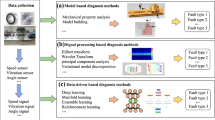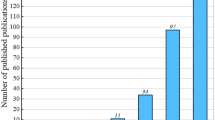Abstract
Data-driven deep learning technology has gained many achievements in the field of motor fault diagnosis and prognostics. However, the application objects of those previous studies are commonly limited to the faulty data sharing the similar distribution under unvarying stable working condition. Unfortunately, this limitation is nearly invalid in the real-world scenario, where the working condition is complicated and changes invariably, resulting in the unfavourable situation that the deep representation learning methods of the previous studies always fail in extracting the effective representations for fault diagnosis in real applications. To tackle this issue, inspired by f-divergence estimation, this work takes a different route and proposes an unsupervised deep representation learning approach, named Deep Mutual Information Maximization (DMIM), using variational divergence estimation approach to maximize mutual information (MI) between the input and output of a deep neural network. Meanwhile the representation distribution is automatically tuned by matching to a prior distribution with the same philosophy of Variational Autoencoder. Opposite to previous works which learn representations basically with supervised feedback regulation or unsupervised reconstruction, the proposed unsupervised MI maximization framework aims to make representational characteristics like independence play a bigger role to capture the most unique representations. To verify the effectiveness of our proposal, faulty motor data from the motor tests under European driving cycle for simulating the real working scenario, are collected for validation. It turns out that DMIM outperforms many popular unsupervised and fully-supervised learning methods. It opens new avenues for unsupervised learning of representations for motor fault diagnosis.












Similar content being viewed by others
References
Ali, S. M., & Silvey, S. D. (1966). A general class of coefficients of divergence of one distribution from another. Journal of the Royal Statistical Society: Series B (Methodological), 28(1), 131–142.
Belghazi, M. I., Baratin, A., Rajeswar, S., Ozair, S., Bengio, Y., Courville, A., & Hjelm, R. D. (2018). Mine: mutual information neural estimation. arXiv preprint arXiv:1801.04062.
Benbouzid, E. M. H. (2000). A review of induction motors signature analysis as a medium for faults detection. IEEE Transactions on Industrial Electronics, 47(5), 984–993.
Brakel, P., & Bengio, Y. (2017). Learning independent features with adversarial nets for non-linear ica. arXiv preprint arXiv:1710.05050.
Burgess, C. P., Higgins, I., Pal, A., Matthey, L., Watters, N., Desjardins, G., & Lerchner, A. (2018). Understanding disentangling in β-VAE. arXiv preprint arXiv:1804.03599.
Butte, A. J., & Kohane, I. S. (1999). Mutual information relevance networks: functional genomic clustering using pairwise entropy measurements. In Pacific Symposium on Biocomputing 2000, Honolulu, Hawaii, USA, 5–9 January 2000 (pp. 418–429). https://doi.org/10.1142/4316.
Chegini, S. N., Bagheri, A., & Najafi, F. (2019). Application of a new EWT-based denoising technique in bearing fault diagnosis. Measurement, 144, 275–297.
Chen, X., Duan, Y., Houthooft, R., Schulman, J., Sutskever, I., & Abbeel, P. (2016). Infogan: Interpretable representation learning by information maximizing generative adversarial nets. In Advances in neural information processing systems (NIPS2016), Barcelona, Spain, (pp. 2172–2180).
Chen, T. Q., Li, X., Grosse, R. B., & Duvenaud, D. K. (2018). Isolating sources of disentanglement in variational autoencoders. In Advances in neural information processing systems (pp. 2610–2620).
Chen, L., Zhu, F., Zhang, M., Huo, Y., Yin, C., & Peng, H. (2011). Design and analysis of an electrical variable transmission for a series-parallel hybrid electric vehicle. IEEE Transactions on Vehicular Technology, 60(5), 2354–2363.
Gao, Y., Gao, L., Li, X., & Zheng, Y. (2019). A zero-shot learning method for fault diagnosis under unknown working loads. Journal of Intelligent Manufacturing, 31(1), 899–909.
Guo, L., Lei, Y., Li, N., Yan, T., & Li, N. (2018). Machinery health indicator construction based on convolutional neural networks considering trend burr. Neurocomputing, 292, 142–150.
Guo, L., Li, N., Jia, F., Lei, Y., & Lin, J. (2017). A recurrent neural network based health indicator for remaining useful life prediction of bearings. Neurocomputing, 240, 98–109.
Han, T., Liu, C., Yang, W., & Jiang, D. (2020). Deep transfer network with joint distribution adaptation: A new intelligent fault diagnosis framework for industry application. ISA Transactions, 97, 269–281.
He, J., Yang, S., & Gan, C. (2017). Unsupervised fault diagnosis of a gear transmission chain using a deep belief network. Sensors, 17(7), 1564–1574.
Hjelm, R. D., Fedorov, A., Lavoie-Marchildon, S., Grewal, K., Bachman, P., Trischler, A., & Bengio, Y. (2018). Learning deep representations by mutual information estimation and maximization. arXiv preprint arXiv:1808.06670.
Ji, X., Henriques, J. F., & Vedaldi, A. (2018). Invariant information distillation for unsupervised image segmentation and clustering. arXiv preprint arXiv:1807.06653.
Kingma, D. P., & Welling, M. (2013). Auto-encoding variational bayes. arXiv preprint arXiv:1312.6114.
Kullback, S. (1997). Information theory and statistics. Chelmsford: Courier Corporation.
Li, X., Zhang, W., Ding, Q., & Sun, J. Q. (2020). Intelligent rotating machinery fault diagnosis based on deep learning using data augmentation. Journal of Intelligent Manufacturing, 31(2), 433–452.
Liu, H., Zhou, J., Xu, Y., Zheng, Y., Peng, X., & Jiang, W. (2018). Unsupervised fault diagnosis of rolling bearings using a deep neural network based on generative adversarial networks. Neurocomputing, 315, 412–424.
Maaten, L. V. D., & Hinton, G. (2008). Visualizing high-dimensional data using t-SNE. Journal of machine learning research, 9(1), 2579–2605.
Maes, F., Collignon, A., Vandermeulen, D., Marchal, G., & Suetens, P. (1997). Multimodality image registration by maximization of mutual information. IEEE Transactions on Medical Imaging, 16(2), 187–198.
Makhzani, A., Shlens, J., Jaitly, N., Goodfellow, I., & Frey, B. (2015). Adversarial autoencoders. arXiv preprint arXiv:1511.05644.
Nguyen, X., Wainwright, M. J., & Jordan, M. I. (2010). Estimating divergence functionals and the likelihood ratio by convex risk minimization. IEEE Transactions on Information Theory, 56(11), 5847–5861.
Nowozin, S., Cseke, B., & Tomioka, R. (2016). f-gan: Training generative neural samplers using variational divergence minimization. In Advances in neural information processing systems (NIPS2016), Barcelona, Spain, (pp. 271–279).
Oord, A. V. D., Li, Y., & Vinyals, O. (2018). Representation learning with contrastive predictive coding. arXiv preprint arXiv:1807.03748.
Parker, P. (1994). The concept of NEDC. RSA Journal, 142(5453), 72–72. Retrieved form April 10, 2020, from www.jstor.org/stable/41376580.
Peng, H., Long, F., & Ding, C. (2005). Feature selection based on mutual information criteria of max-dependency, max-relevance, and min-redundancy. IEEE Transactions on Pattern Analysis and Machine Intelligence, 27(8), 1226–1238.
Shao, H., Jiang, H., Zhang, H., Duan, W., Liang, T., & Wu, S. (2018). Rolling bearing fault feature learning using improved convolutional deep belief network with compressed sensing. Mechanical Systems and Signal Processing, 100, 743–765.
Sun, C., Ma, M., Zhao, Z., & Chen, X. (2018). Sparse deep stacking network for fault diagnosis of motor. IEEE Transactions on Industrial Informatics, 14(7), 3261–3270.
Tao, J., Qin, C., Xiao, D., Shi, H., Ling, X., Li, B., et al. (2019a). Timely chatter identification for robotic drilling using a local maximum synchrosqueezing-based method. Journal of Intelligent Manufacturing. https://doi.org/10.1007/s10845-019-01509-5.
Tao, J., Qin, C., Xiao, D., Shi, H., & Liu, C. (2019b). A pre-generated matrix-based method for real-time robotic drilling chatter monitoring. Chinese Journal of Aeronautics, 32(12), 2755–2764.
Wang, C., Gan, M., & Zhu, C. A. (2019). A supervised sparsity-based wavelet feature for bearing fault diagnosis. Journal of Intelligent Manufacturing, 30(1), 229–239.
Xiao, D., Huang, Y., Qin, C., Shi, H., & Li, Y. (2019). Fault diagnosis of induction motors using recurrence quantification analysis and LSTM with weighted BN. Shock and Vibration, 2019(1), 1–14.
Yin, S., Li, X., Gao, H., & Kaynak, O. (2014). Data-based techniques focused on modern industry: An overview. IEEE Transactions on Industrial Electronics, 62(1), 657–667.
Zhang, W., Li, C., Peng, G., Chen, Y., & Zhang, Z. (2018). A deep convolutional neural network with new training methods for bearing fault diagnosis under noisy environment and different working load. Mechanical Systems and Signal Processing, 100, 439–453.
Zhao, M., Kang, M., Tang, B., & Pecht, M. (2017). Deep residual networks with dynamically weighted wavelet coefficients for fault diagnosis of planetary gearboxes. IEEE Transactions on Industrial Electronics, 65(5), 4290–4300.
Zhao, R., Yan, R., Chen, Z., Mao, K., Wang, P., & Gao, R. X. (2019). Deep learning and its applications to machine health monitoring. Mechanical Systems and Signal Processing, 115, 213–237.
Zhou, Q., Yan, P., Liu, H., & Xin, Y. (2019). A hybrid fault diagnosis method for mechanical components based on ontology and signal analysis. Journal of Intelligent Manufacturing, 30(4), 1693–1715.
Acknowledgments
This project is supported by the National Key Technology Research and Development Program of China (No. 2017YFB1302004), National Natural Science Foundation of China Project (No. 51305258), and China Scholarships Council.
Author information
Authors and Affiliations
Corresponding authors
Additional information
Publisher's Note
Springer Nature remains neutral with regard to jurisdictional claims in published maps and institutional affiliations.
Rights and permissions
About this article
Cite this article
Xiao, D., Qin, C., Yu, H. et al. Unsupervised deep representation learning for motor fault diagnosis by mutual information maximization. J Intell Manuf 32, 377–391 (2021). https://doi.org/10.1007/s10845-020-01577-y
Received:
Accepted:
Published:
Issue Date:
DOI: https://doi.org/10.1007/s10845-020-01577-y




